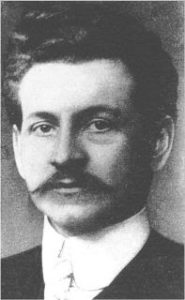In remembrance of Otto Schirmer
Dr. Otto Schirmer (13 December, 1864 – 6 May, 1918)

Otto Schirmer was born in Greifswald, Germany, in 1864. His father was Rudolf Schirmer, an ophthalmologist who published a number of papers on dacryological topics in several German journals.
He had extraordinary musical talent and also an excellent pianist. He also organized many concerts and musical conferences in Greifswald, arranging for the best German performers of the time to play at the Konzertverein of Greifswald.
Schirmer practised Ophthalmology from 1893 to 1907 at Greifswald, showing great surgical skill and oratory ability. His most important publications were about lacrimal secretion and excretion in dacryocystectomized patients (1902); physiology and pathology of lacrimal flow (1903); the influence of blinking on tear drainage (1904); histology and physiology of the lacrimal apparatus (1904); function of the lacrimal mucus in the canaliculi and tear drainage (1906); Toti’s dacryo-cysto-rhinostomy (1908); and innervation of the lacrimal gland (1909). He also worked on the pathology of sympathetic Ophthalmia, Rosacea Keratitis and biochemical studies on cataract.
Evolution of Schirmer’s test:
Schirmer’s most extensive contribution to dacryology was the Schirmer test, a test to evaluate lacrimation. The original idea to measure lacrimal secretion in humans was introduced by Köster who put a piece of blotting paper 10 mm wide and 10–20 mm long in the conjunctival sac of patients, then induced lacrimal secretion by irritating the nasal mucosa with a brush. As each paper became wet, it was replaced by a dry piece, and measurement was continued over a 5–10 minute period or 60–90 minutes. The secretion gradually diminished at variable rates. The goal of this test was to evaluate the functionality of the lacrimal gland by determining the time it took to exhaust its secretion.
Schirmer repeated the Köster test but never observed that the secretion reduced with time, despite prolonging the measurement for 2 or 2 and 1/2 hours. Schirmer modified Köster’s test for more practical clinical use, seeking to determine the quantity of lacrimal secretion during a 5-minute period, rather than the time required to exhaust the secretion of the lacrimal gland. He used blotting paper in strips 5 mm wide and 35 mm long, in which the first 5 mm were folded for introduction in the lateral half of the lacrimal sac. The rest of the strip hungover and in front of the lower lid. After 5 minutes, he measured the length of the external strip that was wetted with tears.
Three Methods of Schirmer:
Schirmer published 3 methods to evaluate lacrimation.
Method I
The patient had to stay in the examination office, blinking normally with no intense lights around for 5 minutes. The first 5 mm, which had been inside the lacrimal sac, was discarded, and the length of the wet patch in the rest of each strip was measured. Schirmer considered normal wetting to be over 15 mm. Less wetting was considered to be the damage of afferent pathway of the conjunctivo-lacrimal reflex.
Method II
He anaesthetized lacrimal sac with topical cocaine, placed the paper strips. Introduced a brush deeply in the right nasal fossa, rotating and shifting it. Bilateral tearing appeared, greater in the right eye. Two minutes later, the paper strips were removed and measured. Wetting of 15 mm or more was considered to be normal.
Method III
After topical anaesthesia instillation, strips were placed and the patient was asked to look at the sun. He did not specify the duration and quantification of its results. This test was used along with Method I and II to check for trigeminal activity. He considered these 3 methods to demonstrate reflex secretion via different reflex pathways: Method I in the ocular surface and lid surface; II in the nasal mucosa; and III in the retina.
The material of the paper strip was standardized by De Rötth (1941), using Whatman No. 41 filter paper, and this is the present standard for most clinicians.
Conclusion
For over a century, hundreds of variants have been proposed to improve the results of tests of lacrimal secretion. The paper strips have been replaced by cotton threads, and the duration of the test has been modified. It is undoubtedly the most widely criticized test of tear secretion. Moreover, it remains the most commonly used test in clinical practice.